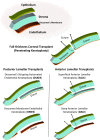High-risk Corneal Transplantation: Recent Developments and Future Possibilities
- PMID: 31765363
- PMCID: PMC6867666
- DOI: 10.1097/TP.0000000000002938
High-risk Corneal Transplantation: Recent Developments and Future Possibilities
Abstract
Human corneal transplantation (keratoplasty) is typically considered to have superior short- and long-term outcomes and lower requirement for immunosuppression compared to solid organ transplants because of the inherent immune privilege and tolerogenic mechanisms associated with the anterior segment of the eye. However, in a substantial proportion of corneal transplants, the rates of acute rejection and/or graft failure are comparable to or greater than those of the commonly transplanted solid organs. Critically, while registry data and observational studies have helped to identify factors that are associated with increased risk of corneal transplant failure, the extent to which these risk factors operate through enhancing immune-mediated rejection is less clear. In this overview, we summarize a range of important recent clinical and basic insights related to high-risk corneal transplantation, the factors associated with graft failure, and the immunological basis of corneal allograft rejection. We highlight critical research areas from which continued progress is likely to drive improvements in the long-term survival of high-risk corneal transplants. These include further development and clinical testing of predictive risk scores and assays; greater use of multicenter clinical trials to optimize immunosuppressive therapy in high-risk recipients and robust clinical translation of novel, mechanistically-targeted immunomodulatory and regenerative therapies that are emerging from basic science laboratories. We also emphasize the relative lack of knowledge regarding transplant outcomes for infection-related corneal diseases that are common in the developing world and the potential for greater cross-pollination and synergy between corneal and solid organ transplant research communities.
Conflict of interest statement
The authors declare no conflicts of interest.
Figures


References
-
- Zirm EK. Eine erfolgreiche totale keratoplastik (a successful total keratoplasty). 1906. Refract Corneal Surg 19895258–261 - PubMed
-
- Tan DTH, Dart JKG, Holland EJ, et al. Corneal transplantation. Lancet 20123791749–1761 - PubMed
-
- Pascolini D, Mariotti SP. Global estimates of visual impairment: 2010. Br J Ophthalmol 201296614–618 - PubMed
Publication types
MeSH terms
Substances
LinkOut - more resources
Full Text Sources
Medical

